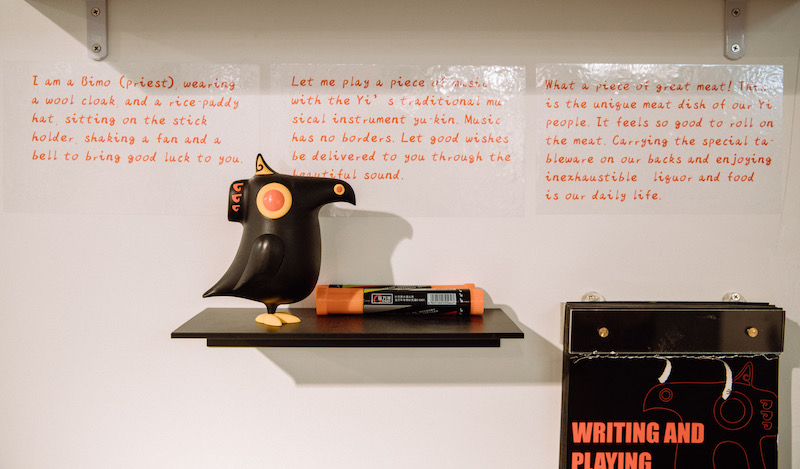Above: 1. China Academy of Art exhibition / 2. Bibo Wu / 3. & 4. Eagle Hawk, Chen Chen / 5. Non-traveller, Neng Huang / 6. Yi pattern mystery of Gan, Hui Zhang / 7. Yi’s Rolling wool by Guixin Xu / 8. Three days, Yizhen Zhou / 9. Gan-mo-a-niu & Flaming Butterfly, Lin Xi / 10. Sweet & Spicy, Dong Sichun
For this edition of London Design Festival, China Academy of Art facilitated by London-based China Design Centre presented an exhibition entitled Designing the rural-Design for social good that saw professionals, teachers and students work with artisans from some of the most rural regions of China.
The projects focused on the concept of ‘targeted poverty alleviation’, which was based on field trips by the academy to three rural areas in China. The Yi ethnic group dwelling in Xiaoliangshan, the Miao settlement in the deep southeast of Guizhou, and the fishing village in the coastal area of Zhejiang… the Academy chose these ‘three mountains’ as the site for local experiments and design teaching.
Students and teachers from China Academy of Art studied the local crafts and culture, then came out with solutions to provide a sustainable and commercially successful way to improve the life of the local people and protect the craftsmanship. It took two years and four schools, with the team analysing thousands of national patterns, consulting a large number of ancient books and related literature, and finally producing 272 works.

Bibo Wu
Highlights from the collaboration with Yi artisans included a printed accessories collections Gan-mo-a-niu and Cha-er-wa by lecturer Bibo Wu with Tiange Xu, Yue Wu, Yan Li, using traditional motifs and pleating techniques. The Yi legend “Gan-mo-a-niu” tells a mystical and tragic story of the beautiful Ganmoaniu and her embroidery works, compelled to marry someone she does not love and lost her life in prison at the end. Plus the element of “Cha-er-wa,” a Yi tradition cape made of wool, intended to protect her and stop her from suffering.
Non-traveller by Neng Huang is inspired by the traditional decorative motifs for sheep, horses, water, leaves, stars, rainbows etc. Traditional yi hand embroidery with three-dimensional lines give the patterns more local features, and allows the work its association with local craftsmen.

Eagle Hawk, Chen Chen
Eagle Hawk by Chen Chen is inspired by the Yi worship of the eagle. Saku is a cute Yi eagle, with dark eyes and yellow-red round eyes, often playing the harpsichord, eating the meat, and practicing Bimo in the festival. In the Yi people, black represents the most noble level, and at the same time symbolizes the power of the earth, yellow represents harvest and joy, and red represents flame and life. Chen Chen hopes that Saku can infect us with the mysterious beauty of the Yi people.
The Yi pattern mystery of Gan by Hui Zhang is a picture book for children, which depicts and tells the patterns and stories of the Yi people. With the migration of rural population to the city, the traditional culture of Yi nationality in remote villages has been gradually lost. Through this book, the children of the Yi people can better understand their own culture and national spirit.
Possibilities of handicraft -Yi’s Rolling wool by Guixin Xu is a handcrafted collection of wool cushions, blankets inspired by the patterns found in the Yi people’s lacquer painting. Three days by Yizhen Zhou is a series of jewellery using ebony, lacquer, silver and brass inspired by the Yi tradition of praying for a good harvest with the rites involving fire.
The Sweet & Spicy embroidered wall hanging by Dong Sichun uses the taste of food as a source of inspiration for design, aims to introduce us a story about taste and feelings. While designing it, the designer tried to express her emotions of ‘hometown’ and ‘the place far away from hometown’ through the visual language of patterns and colours, to convey to the viewers the emotional connection between food and people, food and society, food and culture.
We also loved the selection of handpainted accessories designed by Lin Xi depicting fantasy imagery on rucksacks and make-ups bags.
Exhibiting Artists:
Ni Xianou, Wu Bibo, Zhou Donghong, Lang Qing, Chen Yunjia, Lin Yinji, Dong Sichun, Tian Wei, Ma Yichen, Liu Xinyu, Lv Hanchang, Liu Lixin, Xu Tiange, Wu Yue, Li Yan, Li Liang, Wang Xiaoya, Xu Jiaxin, Huang Neng, Xu Guixin, Zhang Hui, Lin Xi, Chen Chen, Wang Jingchao, Liu Chun, Zhu Yan, Zhang Xiya, Zhou Yizhen, Lei Linlin, Zhuo Weiyang, Liu Yi, Xia Fan, Chen Xumin, Peng Jiaxian, Huang Xiaoli, Li Mingqiang, Chen Ruping, Wang Bohan, Li Xiaoxia, Mao Xiaping, Qingjing Studio, Simon Fraser, Kate Sedwell, Lorna Jean Philpot, Leonid Krykhtin.
Learn more about China Academy of Art from their website.
Image credits: photography by Phoebe Guo